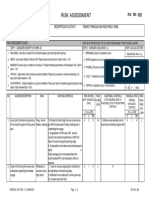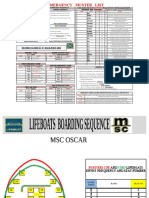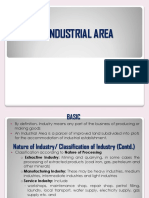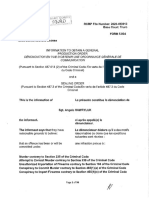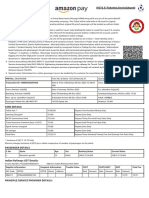#014 Working Aloft
#014 Working Aloft
Uploaded by
Tolias EgwCopyright:
Available Formats
#014 Working Aloft
#014 Working Aloft
Uploaded by
Tolias EgwCopyright
Available Formats
Share this document
Did you find this document useful?
Is this content inappropriate?
Copyright:
Available Formats
#014 Working Aloft
#014 Working Aloft
Uploaded by
Tolias EgwCopyright:
Available Formats
AKRON RISK ASSESSMENT R/A NO : 014
TYPE OF ACTIVITY: ROUTINE / NON- DESCRIPTION OF ACTIVITY : WORKING ALOFT
ROUTINE
RISK ASSESSMENT GUIDE : RISK MUST BE REDUCED TO AS LOW AS REASONABLY PRACTICABLE (ALARP)
STEP 1 : CONSIDER SEVERITY OF HARM (S) STEP 2 : CONSIDER LIKELIHOOD (L) STEP 3:CALCULATE RISK
1: NEGLIGIBLE: Near Miss or Simple First Aid/ Simple Repairs by ship staff/ Spill within spill trays 1: IMPROBABLE-Event not expected to occur RISK RATING RR = S x L
2: MINOR : Injury require Medical Treatment; MTC/ Repair need external assistance / Spill on deck < 1 m3 2 : RARE: Expected to occur in exceptional situations RR RISK CATEGORY
MODERATE: Serious injury or multiple minor injuries; LTI / Repairs affecting seaworthiness of ship leading to CoC / Spill on
3: 3: POSSIBLE: May occur at some time / occurred in the past
deck > 1 m3 1- 5 L - LOW
CRITICAL : Single fatality, Serious injuries, permanent disability / Requires lay up repairs or extensive drydockings, 3rd party
4: 4: LIKELY : Possibility of occurrence of isolated incidents
claims/ Spill overboard < 100L 6 - 10 M - MEDIUM
CATASTROPHIC : Mutiple Fatalaities or Long Term disabilities/ Total Loss of ship or immediate layup/dry-docking for major
5: 5: CERTAIN: Is expected to occur in most situations
repairs / Major overboard spill > 100 L 11 - 25 H - HIGH
NO HAZARD DESCRIPTION RISK EXISTING CONTROLS RISK RATING RISK ADDITIONAL CONTROLS RESIDUAL RISK RESI-
(WITH CONTROLS IN CATEG (IF NOT REQUIRED, WRITE "N". RATING DUAL
PLACE) L/M/H IF REQUIRED, LIST OUT THE ADDITIONAL (WITH ADDIT'L RISK
CONTROLS ) CONTROLS) CAT.
( S x L= RR) (S x L = RR) L/M/H
S L RR S L RR
1. Personnel falling while working aloft 1.Fatality, Serious 1. Personnel under 18 years of age or with less than 4 2 8 M 1. Ensure the platform, staging to be 4 1 4 L
Injury, Permanent 12 months experience at sea, should not work aloft used are in good condition and to be
or Partial unless accompanied by an experienced person or put in place under the supervision of
Disability. otherwise adequately supervised. 2. Complete the supervisor. Check the condition
Working aloft/overside permit no S-12 prior to of all equipment being used are in
commencement of work. good condition. 2. Saftey net to be
3. Ref to Code to safe working practices, Chapter rigged if practicable.
15 and VOM . 3. If the job is below 2 meters above
4. Safety harness must be worn while working aloft deck then the ladder being used
(above 2 meters) with a lifeline or other arresting should be properly anchored or
devise attached to it. secured so as to avoid inadvertant
5. Personnel Protection Equipment must be worn movement of the ladder.
especially Helmets with "Chin-Straps" and eye
protection
6. Provide Safety Induction Training / special training
regarding the work at height.
7. Full body safety harness shall be anchored with
permanent and strong structure.
FORM NO: S-20 / REV. 0 / 01 MAR 2010 Page 1 / 4 R/A NO :014
NO HAZARD DESCRIPTION RISK EXISTING CONTROLS RISK RATING RISK ADDITIONAL CONTROLS RESIDUAL RISK RESI-
(WITH CONTROLS IN CATEG (IF NOT REQUIRED, WRITE "N". RATING DUAL
PLACE) L/M/H IF REQUIRED, LIST OUT THE ADDITIONAL (WITH ADDIT'L RISK
CONTROLS ) CONTROLS) CAT.
( S x L= RR) (S x L = RR) L/M/H
S L RR S L RR
2. Working tools falling down on the 1.Injury from 1. Tools must be used with a tag-line. (apprx 50- 2 2 4 L N
person standing/walking below. falling tool and 70cm rope will be fastened with worker's wrist and
other materials / tool ) this will help tp prevent accidental slip of tools
Property damage. from hand..
2. Nut-bolts and other falling materials must be kept
in safe closed boxes. (fasten with structure) and that
entrances to building and underneath roadways
should be barricaded and a warning notice posted at
the site.
3. Collapse of Telescopic Boom Manlift. 1.Head or 1. Manlifts must not be overloaded. Adequate 4 1 4 L N
Men or material fall from height. Serious bodily controls and supervision must be established.
Injury, Permanent 2. Trained banksmen shall be assigned to give
or Partial signals. Operators shall be trained and certified by
Disability. third party.
3. Use appropriate PPE whilst working with
machines. Tools and other falling materials shall be
kept in safe boxes or fasten with basket to avoid free
falls.
4. Tools must be used with a tag-line. (apprx 50-
70cm rope will be fastened with worker's wrist and
tool ) this will help tp prevent accidental slip of tools
from hand.
4. Vessel in motion at the time of work. 1. Fall from height 1 Avoid working aloft unless it is necessary when the 4 1 4 L N
ship is in motion.
2.Relative wind speed at the site of work to be
assessed weather it is safe for work.
3. In the emergency situation ship's course can be
altered so as to make it safe for waorking at the site.
5 Working near Radar scanner. Hit by a 1. Radiation 1. When the work is to be done near the raddar 3 1 3 L N
revolving scanner. hazard scanner or on the scanner, the officer responsible
2.Electrocution. should inform the officer on watch so that the radar
3. Fall from the and scanner are isolated. A warning notice should be
mast. put on the set until the necessary work has been
completed.
FORM NO: S-20 / REV. 0 / 01 MAR 2010 Page 2 / 4 R/A NO :014
NO HAZARD DESCRIPTION RISK EXISTING CONTROLS RISK RATING RISK ADDITIONAL CONTROLS RESIDUAL RISK RESI-
(WITH CONTROLS IN CATEG (IF NOT REQUIRED, WRITE "N". RATING DUAL
PLACE) L/M/H IF REQUIRED, LIST OUT THE ADDITIONAL (WITH ADDIT'L RISK
CONTROLS ) CONTROLS) CAT.
( S x L= RR) (S x L = RR) L/M/H
S L RR S L RR
6 Working near Radio Aerials on main 1. Radiation 1. Before the work is commenced in the vicinity of 3 1 3 N
mast. hazard from radio aerials, the officer responsible should inform
Aerials. the radio room or the person in charge of radio
2.Electrocution equipment so that no transmissions are made whilst
there is a risk to personnel. A warning notice to be
put in the radio room.
7 Working near Funnel. 1. Health risk 1. When the work is to be done near the funnel, the 3 1 3 N
2. Inhalation of officer responsible should inform the duty engineer to
smoke from ensure that steps are taken to reduce as far as
funnel. practicable the emmision of steam, harmful gases
and fumes. A warning notice should be put on the set
until the necessary work has been completed.
8 Working near Ship's whistle 3. Hearing 1. Complete Working aloft/overside permit no S-12 3 1 3 N
impairment prior to commencement of work.
temporary or 2. Ref to Code to safe working guide chapter 15 and
permanent. VOM Chapter 4, section 8 3.
Before the work is commenced near the ship's
whistle, the officer responsible should ensure that the
power nto whistle is shut off and warning notices
posted on the bridge and in the machinery spaces.
FORM NO: S-20 / REV. 0 / 01 MAR 2010 Page 3 / 4 R/A NO :014
NO HAZARD DESCRIPTION RISK EXISTING CONTROLS RISK RATING RISK ADDITIONAL CONTROLS RESIDUAL RISK RESI-
(WITH CONTROLS IN CATEG (IF NOT REQUIRED, WRITE "N". RATING DUAL
PLACE) L/M/H IF REQUIRED, LIST OUT THE ADDITIONAL (WITH ADDIT'L RISK
CONTROLS ) CONTROLS) CAT.
( S x L= RR) (S x L = RR) L/M/H
S L RR S L RR
9 Fatigue 1. Fall from height 1. Rest hours of all individuals involved must be 4 1 4 L N
considered before delegating the job.
2. Supervisor to monitor the job and if the job
requires extreme physical effort then ensure the
worker is rested to complete the job safely.
Final Asesssment : Provided no deviations from the recommended control measures, the residual risk assessed is As Low As Resonably Practicable (ALARP).
Supplementary measures include correct use of PPE & Tool Box talks that ensure all workers are fully aware of the control measures.
Residual risk - HIGH : If RR is "High" category, written instructions for conducting the job and approval shall be obtained from the shore office to commence the operation.
Residual risk - MEDIUM: If RR is "Medium" , a constant monitoring of events shall be maintained and ensure all identified preventative and mitigating measures are always in place.
PREPARED BY: TECH. DEPT , S & Q DEPT. APPROVED BY: S & Q MANAGER
01 03 2010
FORM NO: S-20 / REV. 0 / 01 MAR 2010 Page 4 / 4 R/A NO :014
You might also like
- Passage Planning Risk Assessment SampleDocument1 pagePassage Planning Risk Assessment SampleRobert M. Maluya100% (1)
- 3.1.4 - EM CK 01 D - Fire in EngineroomDocument1 page3.1.4 - EM CK 01 D - Fire in EngineroomTolias EgwNo ratings yet
- Hickory Police Department Chase PolicyDocument11 pagesHickory Police Department Chase PolicyJames BriertonNo ratings yet
- Per 01a - Cargo Pumproom Entry PermitDocument3 pagesPer 01a - Cargo Pumproom Entry PermitRajesh NairNo ratings yet
- Emd Voucher Dickson Ayodeji OnabajoDocument2 pagesEmd Voucher Dickson Ayodeji OnabajoRCCG Glory House Abu DhabiNo ratings yet
- Onboard Routine Maintenance Check SheetDocument23 pagesOnboard Routine Maintenance Check SheetExpertise MlcsNo ratings yet
- Join DrillDocument2 pagesJoin Drillbinsar800% (1)
- Ast.213.01 - On Board Familiarization FormDocument2 pagesAst.213.01 - On Board Familiarization Formosama100% (2)
- 25 ISM System Familiarization ChecklistDocument1 page25 ISM System Familiarization ChecklistJeet SinghNo ratings yet
- DG1 PDFDocument41 pagesDG1 PDFuye yayaNo ratings yet
- #408 Steering Gear Overhaul or MaintenanceDocument3 pages#408 Steering Gear Overhaul or MaintenanceTolias EgwNo ratings yet
- #101 Anchoring & Weighing AnchorDocument6 pages#101 Anchoring & Weighing AnchorTolias Egw50% (2)
- #204 Navigation Through High Risk Piracy AreaDocument2 pages#204 Navigation Through High Risk Piracy AreaTolias EgwNo ratings yet
- #202 Navigation in Restricted VisibilityDocument2 pages#202 Navigation in Restricted VisibilityTolias EgwNo ratings yet
- #302 Gas Freeing of A Cargo TankDocument4 pages#302 Gas Freeing of A Cargo TankTolias EgwNo ratings yet
- #007 Hot Work Welding On Cargo Tank & Main Deck-01-03-10Document6 pages#007 Hot Work Welding On Cargo Tank & Main Deck-01-03-10Tolias EgwNo ratings yet
- #306 Ballasting - Deballasting OperationDocument3 pages#306 Ballasting - Deballasting OperationTolias EgwNo ratings yet
- #103 Mooring-Unmooring TermnalDocument3 pages#103 Mooring-Unmooring TermnalTolias EgwNo ratings yet
- SIMOPS - Cargo Operation and SIRE InspectionDocument2 pagesSIMOPS - Cargo Operation and SIRE InspectionParmveer SinghNo ratings yet
- Radar LogDocument7 pagesRadar LogDiana cornelia IonNo ratings yet
- CM 05 Cargo Operations Toolbox Talk FormDocument4 pagesCM 05 Cargo Operations Toolbox Talk FormDmitriyNo ratings yet
- RA - Emcy Anchoring in Deep Waters.Document5 pagesRA - Emcy Anchoring in Deep Waters.Nikos Stratis100% (1)
- DRS Feedback Form - DigitalDocument1 pageDRS Feedback Form - DigitalSurya PrakashNo ratings yet
- 05.00.005 Passage Plan - Port ArrivalDocument2 pages05.00.005 Passage Plan - Port ArrivalPHYO MIN Thant100% (1)
- Incident Report Alert: Part A: Vessel InformationDocument1 pageIncident Report Alert: Part A: Vessel InformationDelfin RegisNo ratings yet
- 06 ECDIS Display Configuration & Quick Check PointsDocument1 page06 ECDIS Display Configuration & Quick Check PointsФриланс-студия ISGOTNo ratings yet
- Drill RecordDocument1 pageDrill RecordDarwin DinarTataNo ratings yet
- Approaching Pilot Stations and Embarking and DisembarkingDocument35 pagesApproaching Pilot Stations and Embarking and DisembarkingKazem Love100% (1)
- Ms-I-81 Anchoring and Anchor Watch ChecklistDocument3 pagesMs-I-81 Anchoring and Anchor Watch ChecklistYusuf AnginNo ratings yet
- Bridge Arrival ChecklistDocument1 pageBridge Arrival ChecklistAnonymous fpLGbRDlNo ratings yet
- DKO04-Small Craft Alongside - Incl Bunker Barge, Slop BargeDocument2 pagesDKO04-Small Craft Alongside - Incl Bunker Barge, Slop BargeNang D. VuNo ratings yet
- MAR002 Cargo Operation RecordsDocument35 pagesMAR002 Cargo Operation RecordsStar BornNo ratings yet
- Recovery of Persons From The Water Guidelines For The Development of Plans and ProceduresDocument6 pagesRecovery of Persons From The Water Guidelines For The Development of Plans and ProceduresClive MalliaNo ratings yet
- ER06 BunkeringDocument2 pagesER06 BunkeringNang D. Vu100% (1)
- US 047F - Exercise Checklist 2024 Rev 0Document11 pagesUS 047F - Exercise Checklist 2024 Rev 0fsbv7fx9No ratings yet
- E23a ISGOTT Bunker ChklistDocument4 pagesE23a ISGOTT Bunker Chklistvic.barca2012100% (1)
- ECM GD-09 - Preparation For USCG COC Exam - Rev 1-2015Document5 pagesECM GD-09 - Preparation For USCG COC Exam - Rev 1-2015guoterryNo ratings yet
- TMSA3 Review and Study NYK Panel Discussion Jul 17Document13 pagesTMSA3 Review and Study NYK Panel Discussion Jul 17Genghu YeNo ratings yet
- VOC MANAGEMENT PLAN RevA - 0311123Document67 pagesVOC MANAGEMENT PLAN RevA - 0311123ene oanaNo ratings yet
- International Anti-Fouling System Certificate: Particulars of ShipDocument2 pagesInternational Anti-Fouling System Certificate: Particulars of ShipLegal EnvitecNo ratings yet
- Towage-ManualDocument14 pagesTowage-Manualahmed shreifNo ratings yet
- Deck Crane Greasing Aug. WORKING ALOFT MayDocument3 pagesDeck Crane Greasing Aug. WORKING ALOFT MayKevin KrisdiantoNo ratings yet
- Vetting Inspectors.Document5 pagesVetting Inspectors.Pavel ViktorNo ratings yet
- Passage Plan Flow ChartDocument1 pagePassage Plan Flow ChartКирилл Ананченко100% (2)
- Fire in Engine Room: Ship'S NameDocument2 pagesFire in Engine Room: Ship'S NameMehmet BakışkanNo ratings yet
- Emcy Towing Booklet 99Document24 pagesEmcy Towing Booklet 99Aung Htet KyawNo ratings yet
- Nav-00 PASSAGE PLANDocument25 pagesNav-00 PASSAGE PLANIrakli BakuridzeNo ratings yet
- Ship/Shore Safety Check ListDocument3 pagesShip/Shore Safety Check ListAshutosh Singh100% (1)
- CO Handing Over NotesDocument7 pagesCO Handing Over Notesalive2flirt100% (2)
- Onboard Vetting Checklist (Rev.0)Document269 pagesOnboard Vetting Checklist (Rev.0)Alper Mert100% (1)
- Bridge-125 Coastal and Restricted Waters ChecklistDocument2 pagesBridge-125 Coastal and Restricted Waters ChecklistMiha Mihaela100% (1)
- Individual Poster Muster ListDocument35 pagesIndividual Poster Muster ListAsifur Rahman100% (1)
- HSM Manual 15 July 22Document308 pagesHSM Manual 15 July 22Rachit Sharma100% (1)
- Mooring Line Management PlanDocument3 pagesMooring Line Management Planghonwa hammodNo ratings yet
- The Human FactorDocument38 pagesThe Human FactorMuhammad100% (2)
- ECDIS - Onboard Training PackDocument51 pagesECDIS - Onboard Training PackRajeev YadavNo ratings yet
- Loading PlanDocument6 pagesLoading PlanIordache Dumitru100% (1)
- Waste Management PlanDocument6 pagesWaste Management PlanTom AlexNo ratings yet
- Muster List & Boarding Sequences 20.03.2023Document2 pagesMuster List & Boarding Sequences 20.03.2023SenpaiNo ratings yet
- Final Report MV Blue StarDocument19 pagesFinal Report MV Blue StarПомощникПомощникNo ratings yet
- 0621 Pocket Guide PrintoutDocument8 pages0621 Pocket Guide PrintoutMuhammadNo ratings yet
- #025 Installation of Anodes in W.B.T. (New)Document3 pages#025 Installation of Anodes in W.B.T. (New)Tolias EgwNo ratings yet
- #016 Underwater OperationsDocument3 pages#016 Underwater OperationsTolias Egw100% (1)
- #402 Valve Overhauling in A Cargo TankDocument4 pages#402 Valve Overhauling in A Cargo TankTolias EgwNo ratings yet
- Jacob LadderDocument1 pageJacob LadderTolias EgwNo ratings yet
- 2 Threshold Voltage PDFDocument8 pages2 Threshold Voltage PDFTolias EgwNo ratings yet
- 1-DD-Akron-CORA-9519705-PROP-60 Months Commercial Paint Delivery 2018-07-18 PDFDocument3 pages1-DD-Akron-CORA-9519705-PROP-60 Months Commercial Paint Delivery 2018-07-18 PDFTolias EgwNo ratings yet
- 2T10-12mHSGK220-160-2400-1755 ModelDocument1 page2T10-12mHSGK220-160-2400-1755 ModelTolias EgwNo ratings yet
- 02.1 - HSE - Policy-01 03 16 PDFDocument1 page02.1 - HSE - Policy-01 03 16 PDFTolias EgwNo ratings yet
- 2.PC Jotun Chart1011 PDFDocument3 pages2.PC Jotun Chart1011 PDFTolias EgwNo ratings yet
- 3.6 - EM CK 06 - Man Overboard and Recovery From WaterDocument1 page3.6 - EM CK 06 - Man Overboard and Recovery From WaterTolias EgwNo ratings yet
- 1 3638 5049 02 PDFDocument1 page1 3638 5049 02 PDFTolias EgwNo ratings yet
- 1-DD-Akron-CORA-9519705-PROP-60 Months Technical Specification 2018-07-18 PDFDocument8 pages1-DD-Akron-CORA-9519705-PROP-60 Months Technical Specification 2018-07-18 PDFTolias EgwNo ratings yet
- 1 3638 5012a 02 PDFDocument2 pages1 3638 5012a 02 PDFTolias EgwNo ratings yet
- 1.apexior 3 PDFDocument1 page1.apexior 3 PDFTolias EgwNo ratings yet
- 1.unimarine Equivalent List PDFDocument3 pages1.unimarine Equivalent List PDFTolias EgwNo ratings yet
- 1 3500 4109a 02 PDFDocument3 pages1 3500 4109a 02 PDFTolias EgwNo ratings yet
- 1 3638 1204a 02 PDFDocument1 page1 3638 1204a 02 PDFTolias EgwNo ratings yet
- 01-6 Complaint Procedures-R0-15 05 13-Ud 01 07 13 - RINA - PDFDocument5 pages01-6 Complaint Procedures-R0-15 05 13-Ud 01 07 13 - RINA - PDFTolias EgwNo ratings yet
- 0service Bulletin List For 2Document2 pages0service Bulletin List For 2Tolias Egw100% (1)
- 1 3500 1183a 02 PDFDocument3 pages1 3500 1183a 02 PDFTolias EgwNo ratings yet
- #405 Maintenance of Emergency GeneratorDocument2 pages#405 Maintenance of Emergency GeneratorTolias Egw100% (1)
- Oxy-Acetelyne Regulation SIRE Vessel Inspection Questionnaire - VIQ 7 PDFDocument1 pageOxy-Acetelyne Regulation SIRE Vessel Inspection Questionnaire - VIQ 7 PDFTolias EgwNo ratings yet
- 01 General Conditions PDFDocument5 pages01 General Conditions PDFTolias EgwNo ratings yet
- #412 Identification of Critical Equipment and Spares LevelsDocument3 pages#412 Identification of Critical Equipment and Spares LevelsTolias EgwNo ratings yet
- #404 Emergency Fire Pump Maintenance (Revised)Document4 pages#404 Emergency Fire Pump Maintenance (Revised)Tolias EgwNo ratings yet
- #501 Bunkering OperationsDocument5 pages#501 Bunkering OperationsTolias EgwNo ratings yet
- 0service Bulletin List ForDocument3 pages0service Bulletin List ForTolias Egw100% (1)
- EASA_AD_2024-0249_1Document3 pagesEASA_AD_2024-0249_1sma.ciopaerNo ratings yet
- Bahan Interview - Master OffshoreDocument42 pagesBahan Interview - Master OffshoreassenNo ratings yet
- From To: Voyage ExpressDocument2 pagesFrom To: Voyage Expressibroyala16-scribeNo ratings yet
- Hes PlanDocument2 pagesHes PlanNAZAR ALINo ratings yet
- Fire in Engine Room: Ship'S NameDocument2 pagesFire in Engine Room: Ship'S NameMehmet BakışkanNo ratings yet
- 5 - CS Terminal Regulations 2017Document105 pages5 - CS Terminal Regulations 2017Robert ArrindellNo ratings yet
- GMDSS - Circ23 2019Document2 pagesGMDSS - Circ23 2019Leonardo Polo Abril0% (1)
- Industrial AreaDocument15 pagesIndustrial AreaFaria HossainNo ratings yet
- Readme Agerskov Mod 1.2 PDFDocument3 pagesReadme Agerskov Mod 1.2 PDFUNAI IZURANo ratings yet
- TMI Ch2-2 Navigation LightsDocument11 pagesTMI Ch2-2 Navigation Lightsjoypal2501No ratings yet
- NRSAP 2021-30 Draft Final 14apr22 1658832893Document159 pagesNRSAP 2021-30 Draft Final 14apr22 1658832893black webNo ratings yet
- Road Safety Implementation ToRDocument3 pagesRoad Safety Implementation ToRShivinder BhandariNo ratings yet
- Information To Obtain (Redacted) 0718Document94 pagesInformation To Obtain (Redacted) 0718Brian Hill100% (3)
- Denizcilik Ingilizcesi III (10 - Hafta)Document6 pagesDenizcilik Ingilizcesi III (10 - Hafta)emircan demirkayaNo ratings yet
- CHAPTER 10-Ship ClearanceDocument52 pagesCHAPTER 10-Ship ClearancePatrick MaliksiNo ratings yet
- Resident Handbook 2019 2021Document47 pagesResident Handbook 2019 2021Gary LoweNo ratings yet
- Sea of Opportunities (By Shreyas Mahale)Document80 pagesSea of Opportunities (By Shreyas Mahale)Shreyas MahaleNo ratings yet
- RequirementDocument2 pagesRequirementrakeshbiswaNo ratings yet
- RA - Cables PullngDocument12 pagesRA - Cables PullngIbrahim EsmatNo ratings yet
- Traffic Notification For One Way Restriction in Kolkata CityDocument10 pagesTraffic Notification For One Way Restriction in Kolkata CitySujoyDeNo ratings yet
- MN 7 038 2Document28 pagesMN 7 038 2Valrik IIINo ratings yet
- Modulo - Rientro - Sintetico - 05 - Marzo - 2021 - Eng - 1Document1 pageModulo - Rientro - Sintetico - 05 - Marzo - 2021 - Eng - 1Giniro SayuriNo ratings yet
- E100 - Voltage Drop Calculations: DNV GL AsDocument9 pagesE100 - Voltage Drop Calculations: DNV GL AsOIUKNo ratings yet
- Electronic Reservation Slip IRCTC E-Ticketing Service (Agent)Document3 pagesElectronic Reservation Slip IRCTC E-Ticketing Service (Agent)Nitish SinghNo ratings yet
- Airport Maintenance Foreman Description 14Document3 pagesAirport Maintenance Foreman Description 14Ameer BabylonianNo ratings yet
- Lesson 2Document8 pagesLesson 2jaiqcooNo ratings yet
- 75306RE Eng 2015 - 01Document195 pages75306RE Eng 2015 - 01Sladjan100% (1)












